By Contributing Editor Cynthia Houng

I first encountered Abbot Suger: On the Abbey Church of St.-Denis and Its Art Treasures, edited, translated and annotated by Erwin Panofsky (1946, 2nd. revised and expanded edition 1979) when I was working on a paper on the stained glass program at Sainte-Chapelle. Abbot Suger is a remarkable set of texts. In this book, Panofsky gathered three important documents related to the construction of St.-Denis by Suger: De Administratione, De Consecratione, and the Ordinatio, all written between 1140 and 1149, the decade surrounding the cathedral’s construction and consecration, between c. 1140 and c. 1144.
Two weeks ago, transfixed by the fire at Notre Dame, I went to my shelf and pulled down my copy of Abbot Suger.
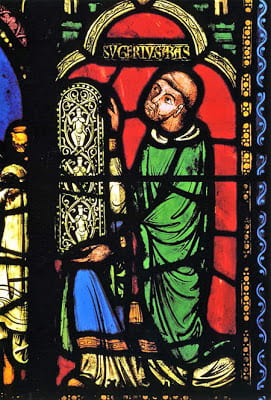
Abbot Suger, donating the Tree of Jesse window to St.-Denis
In his introduction to Suger’s text, Panofsky noted that, “Suger was acutely conscious of the stylistic difference that existed between his own, ‘modern’ structures (opus novum or even modernum) and the old Carolingian basilica (opus antiquum).” Suger tells us what it was like to experience the lightness and the airy qualities of the Gothic nave for the first time, to stand beneath those stained glass windows with their “wonderful and uninterrupted light.” It is all new, still. The Gothic has not yet become loaded with additional–and sometimes inconvenient, or even unsavory–ideological and emotional resonances.
In Suger’s moment, the Gothic does not have a history yet. It does not even have a name. We do not look back at St.-Denis, or Sainte-Chapelle, or Notre Dame through a haze of romanticism (as Viollet-le-Duc did), nor do we see, as Louis XIV, a tired relic of the past (Louis XIV modernized Notre Dame’s interior to suit his own Classical tastes). The association with the Gothic with the ancien régime has not yet happened, and we do not see it, as French revolutionaries did in the eighteenth century, and again in the nineteenth, as part of the order that must be destroyed. (Sainte-Chapelle’s glorious glass windows survive only because they were removed and packed away before revolutionaries could smash them.) No, to see St.-Denis through Suger’s eyes is to see both a new world rising, and the difficulty of making something so new that it was untested–and if it were to endure, it would do so only by the grace of God.
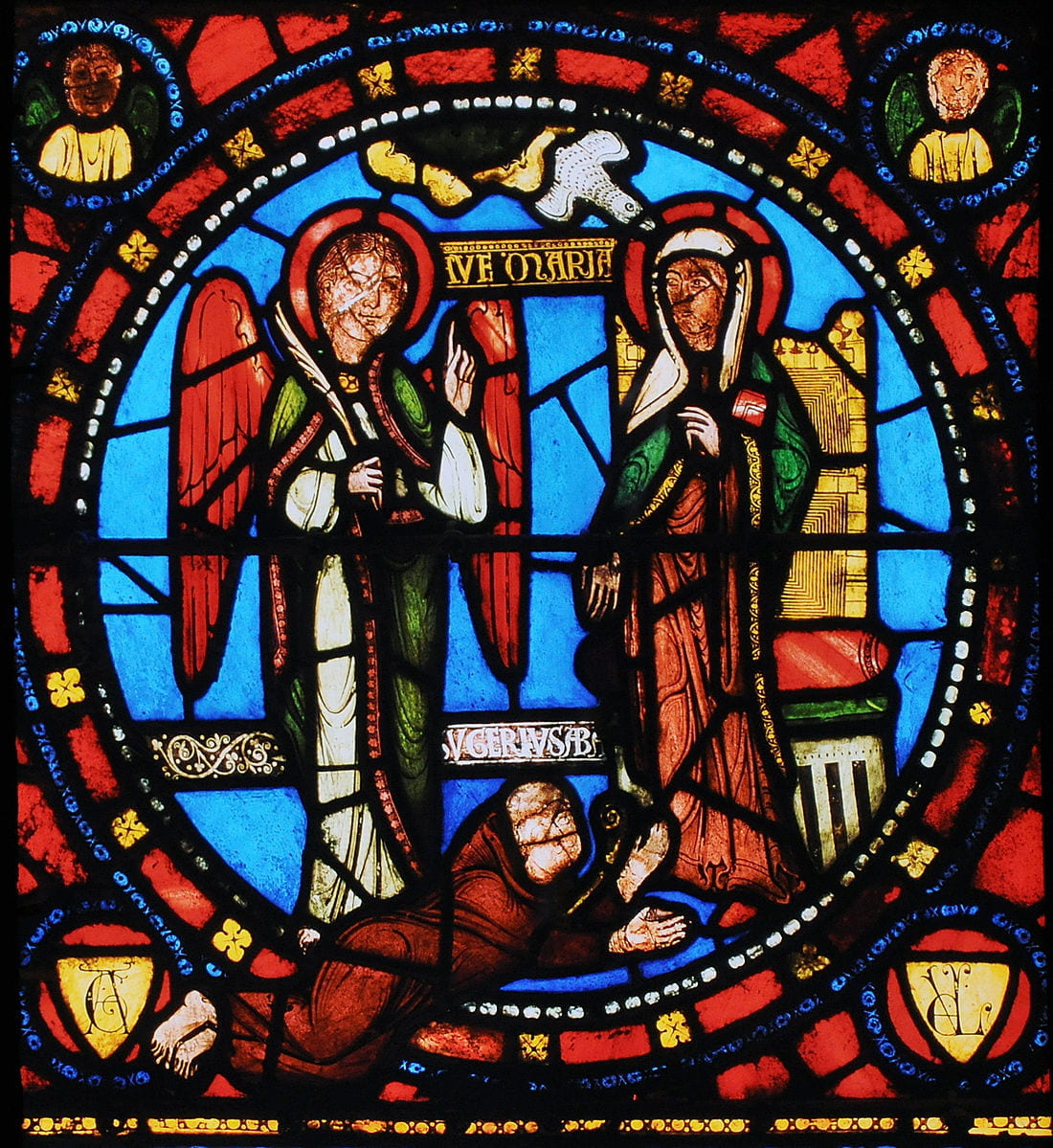
A donor portrait of Abbot Suger, “The Annunciation,” from the axial chapel of the Virgin at St.-Denis
Writing on the survival of St.-Denis’s “arches” (the arches that formed part of the cathedral’s vaulting) through a heavy storm that hurled “a force of contrary gales” against them, so that “they threatened baleful ruin at any moment, miserably trembling, and as it were, swaying hither and thither,” Suger said: “Thus [the tempest], while it brought calamitous ruin in many places to buildings thought to be firm, was unable to damage these isolated and newly made arches, tottering in mid-air, because it was repulsed by the power of God.” (109) Suger’s text is full of such instances, at once marveling at the cathedral structure as a feat of construction and engineering, and giving thanks to God that we, mere mortals, could complete such feats in our temporal world. The miracle of St.-Denis, in many ways, is that it happened at all, that resources were found and hands and bodies were set to the task. When we say that these cathedrals were “well built,” we are commenting, in part, on this remarkable conjunction of human and natural resources.
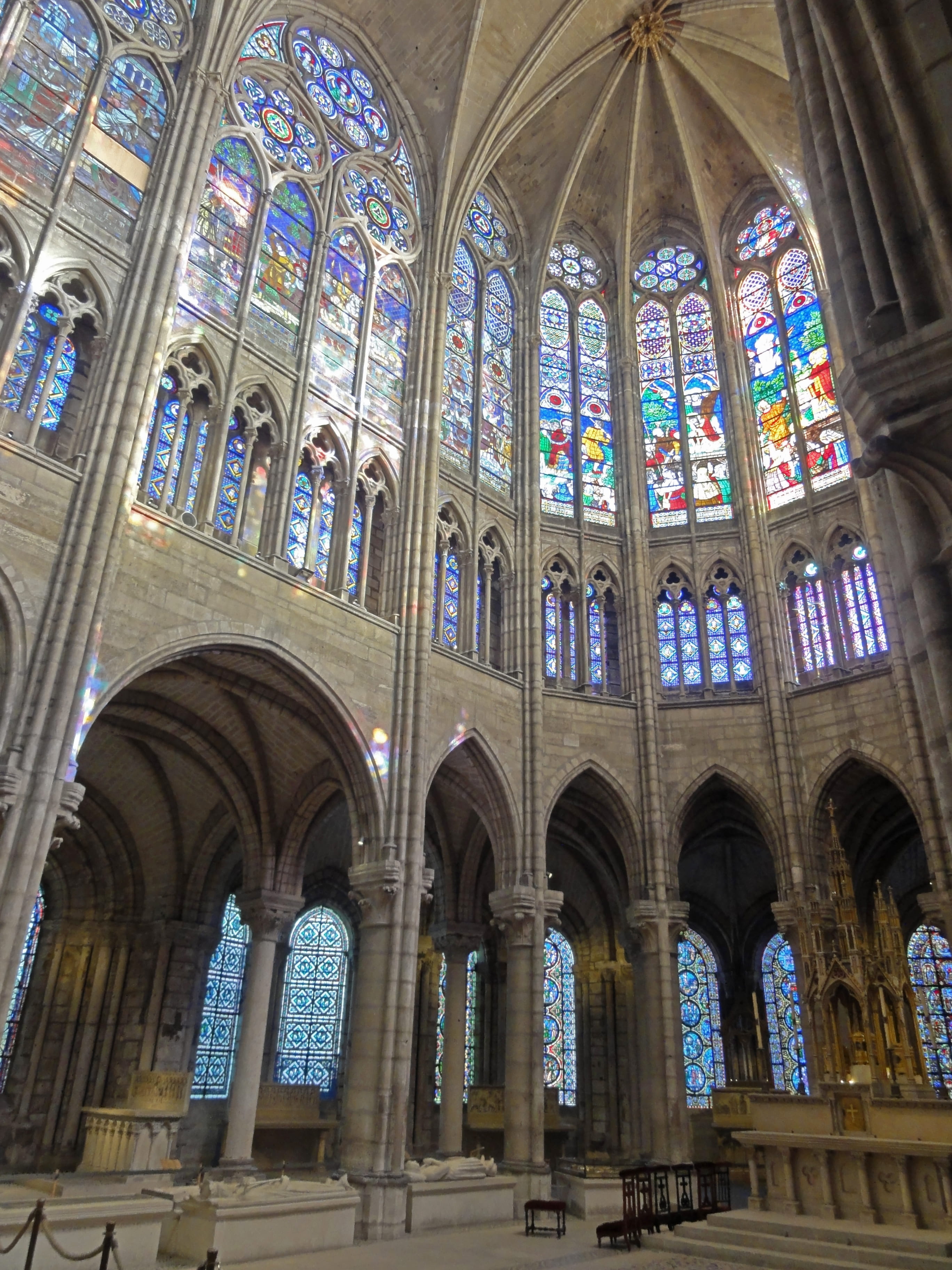
Choir, with vaulting and stained glass, Abbey of St.-Denis
Suger describes what went into the construction process–endless hours of physical labor, but also the less tangible work of funding it all. He tells us remarkable stories of men, “nobles and common folk alike,” harnessing themselves like “draft animals” to draw massive stone columns out of the quarries of Pontoise. He also tells us about combing through the abbey’s accounts, searching for ways to fund “an annual revenue for completing this work,” and finding it by cobbling together income from various offerings, income “from the possession called Villaine in the district of Beauce, previously uncultivated but with the help of God and by our labors brought under cultivation and developed to an annual revenue of eighty or a hundred pounds,” and then providing contingencies in case revenue from Villaine “should fall short of its full contribution.” This small aside on Villaine also tells us something about how the landscape around St.-Denis was changing, as more and more land was improved and brought under cultivation. Revenue from the Fair, too, would play a part in funding the construction. With a light touch, the world of eleventh-century France comes to life. It is not hard to imagine similar considerations in the construction of Notre Dame, though work there was drawn out over a much longer period of time — Stokstad writes that “Pope Alexander, exiled in France, is traditionally believed to have laid the first stone of the choir in 1163,” and yet the facade would not be completed until well into the thirteenth century.
*
Of course, by now, we all know that the Notre Dame fire began in “la forêt,” the forest of ancient timbers that carried the cathedral’s roof. Suger’s text reminds us that such massive roofs were, if not outright miracles, incredible feats of planning and ingenuity, down to the problem of procurement. As he recounts in De Consecratione, the process of finding timber beams for St.-Denis was fraught: “When we inquired of our own carpenters and those of Paris where we might find beams we were told, as was in their opinion true, that such could in no wise be found in these regions owing to the lack of woods; they would inevitably have to be brought hither from the district of Auxerre.” Not easily discouraged, Suger “began to think in bed that I myself should go through all the forests of these parts, look around everywhere.” The next morning, “we hastened with our carpenters, and with the measurements of the beams, to the forest called Iveline. When we traversed our possession in the Valley of Chevreuse we summoned through our servants the keepers of our own forests as well as men who knew about other woods, and questioned them under oath whether we could find there, no matter with how much trouble, any timbers of that measure. At this they smiled, or rather would have laughed at us if they had dared.” And here Suger gives a wonderful aside on the recent history of France, noting that his queries were met with smiles because the men “wondered whether we were quite ignorant of the fact that nothing of the kind could be found in the entire region, especially since Milon, the Castellan of Chevreuse (our vassal, who holds of us one half of the forest in addition to another fief) had left nothing unimpaired or untouched that could be used for building palisades and bulwarks while he was long subjected to wars both by our Lord the King and Amaury de Montfort.”
But such are the rewards of faith–or stubbornness. Suger plunges into the forest himself, “and toward the first hour we found one timber adequate to the measure.” At the end of the day, they had found twelve timbers, the exact number required for their task. Suger sums up the episode: “Thus in this matter Divine generosity, which has chosen to limit and to grant all things according to weight and measure, manifested itself as neither excessive nor defective; for not one more [timber] than was needed could be found.”
*
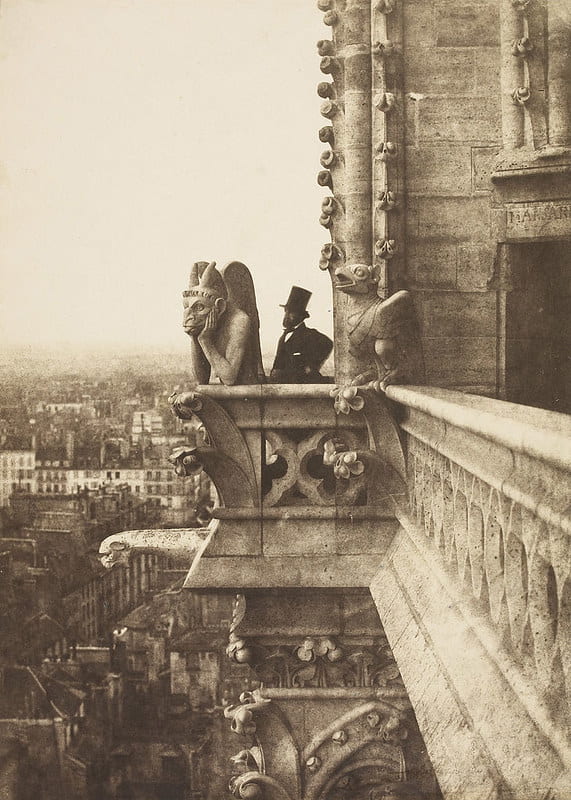
Charles Nègre, The Vampire (Le Stryge), 1853. Salt print on paper.
It is impossible to know Notre Dame without mediation–of representations, of texts, of the intervening centuries themselves. Michael Camille wrote, in the introduction to his strange and wonderful book The Gargoyles of Notre Dame (2007): “What these insistent monsters have taught me is the impossibility of viewing the art of the Middle Ages without looking past and through the nineteenth century, without appreciating our own and the cathedral’s substantial Modernity.” In the case of Notre Dame, it was literally impossible to see the cathedral without the mediation of the nineteenth century, for the fabric of the cathedral was substantially altered under the direction of Eugène-Emmanuel Viollet-le-Duc and Jean-Baptiste Lassus. The spire that fell and burned before our eyes was a Viollet-le-Duc intervention. So are the beloved gargoyles. Viollet-le-Duc’s hand can be felt both inside and out. And the cathedral has been changed since the nineteenth century. In the 1960s, new glass was installed in the nave in an effort to brighten and lighten the dark interior.
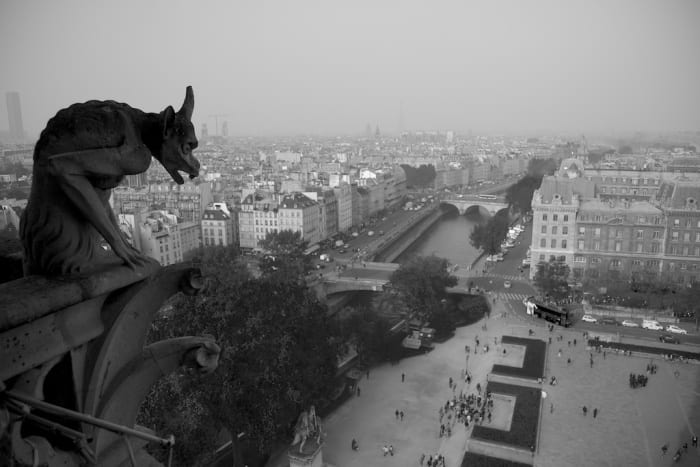
Robert Doisneau, Gargoyle, Notre Dame, 1949.
Camille has something to say about this, too: “In writing the first-ever art-historical study of this group of well-known Parisian sculptures, my point is not that they are modern and therefore less important than the superb twelfth- and thirteenth-century sculptures still in situ on the west facade. Rather than view them as “not medieval” I hope to show their instrumentality in having helped construct the very idea of the medieval. Our most cherished cultural monuments are not the neatly packaged products of a distant and therefore irresponsible historical past. Cathedrals are above all spectacular sites in the here and now, sites that are continually being reinterpreted, reconstructed, and interrupted by new monsters of our own making.”
This, I think, is something that Suger could understand, at least in part, though he probably would not articulate it in quite the same way. The “new” St.-Denis was constructed using the stones of the “old” St.-Denis. As gorgeous as the new cathedral might have been when it was freshly constructed, it only came into the fullness of its beauty when animated by the life of the Church. The final passages of Suger’s De Consecratione are dedicated to the translation of the relics–to the joy and passion of the processions and rituals that brought life into the cathedral, life that could be wondrous and joyful but also edged with terror. The cathedral exists for the moment, for the here and now. But Suger doesn’t share Camille’s world-weary disenchantment. Setting aside whether this disenchantment is a function of personality or of modernity–it suffices to say that Camille’s sense of the “here and now” is quite different from that of Suger, as is his sense of how the present moment interacts with the cathedral site.
Here, I think, we have to be careful about drawing binaries between belief and unbelief, the secular and the sacred. When Notre Dame was on fire, men and women fell to their knees in prayer. Things that we believed to have been swept away by the tides of time may in fact endure in surprising ways. The past glows for us only because we have not experienced it ourselves. Suger told of the remarkable work that went into the construction of St.-Denis. He did not tell us of other important things–of the politics, of the force and violence, of what it might mean to do all of this under the sign of feudalism. As for what all of this means, now, in the here-and-now of 2019, for the rebuilding of Notre Dame–perhaps we can only fumble for words when we are mired in the thick of it.
Camille passed away before Notre Dame burned. For him, back in the first years of this century, the question was not “Will Notre Dame burn to the ground?” but rather “Can we delicately repair the damage of time? Is it acceptable to insert signs of our own time into the fabric of the cathedral? Should we make new gargoyles to replace the old, crumbling nineteenth-century ones that are maybe a little bit Disney and a little bit steampunk, that is, of ‘our moment’?” The terms of the equation have shifted a bit. What is our moment? Who are we? When donations poured in for the rebuilding of Notre Dame–after decades of difficulty raising adequate funds for preservation and maintenance–the size of individual donations pledged by ultra-wealthy donors such as François-Henri Pinault and Bernard Arnault served, for some, as painful instantiations of the gross economic inequality that characterizes the twenty-first century.
The best that I can do, for now, is leave you with this quote from T.J. Clark’s Heaven on Earth (2017):
There are aspects of the human imagination — the attempts that individuals and societies go on making to give overall shape to earthly existence, and have time take on a trajectory and destination; the effort to have pain and powerlessness be bearable, and to answer the question of whether the coherence and fullness of a life in common ought to be seen as an entirely human possibility or as the foreshadowing (the gift, the vision) of a world to come–whose main established metaphors look to be indelible, however often they are subjected to the fires of disbelief. […] The idea of heaven on earth, in particular — of a future close to us in which ‘former things are passed away’– will persist as long as the hellishness of the present demands it.
Perhaps it is all just magical thinking. I know in the thick of it all, when the fire could have gone one way or another, I promised to myself that if Notre Dame were to stand, if “la forêt” should be all that was sacrificed, I would return to the site myself. To see it with my own eyes. Call it what you will — faith, magical thinking, a misguided attempt to project my own desires onto the external world. In the moment it was the only thing I had.
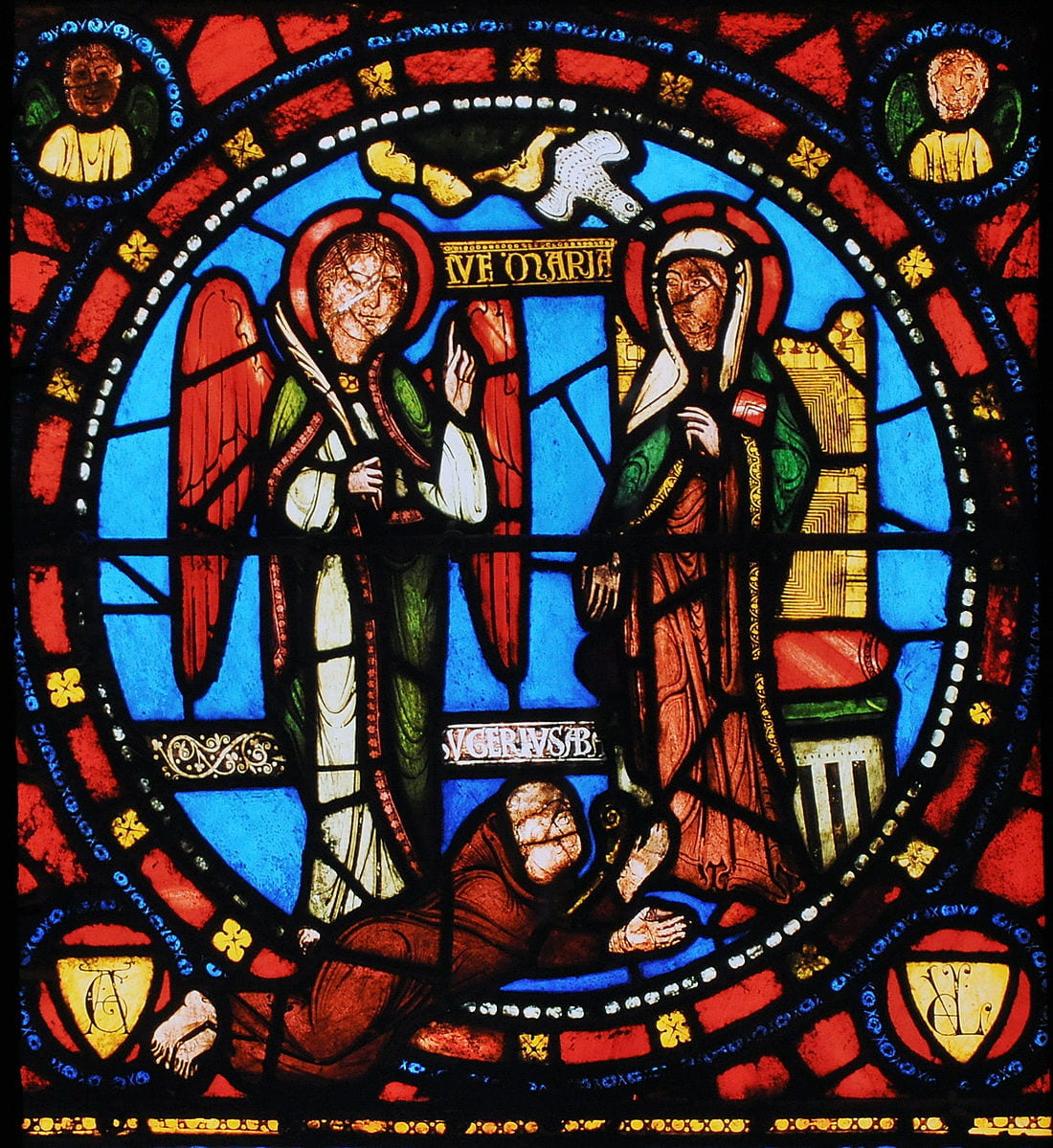



1 Pingback